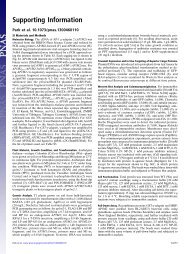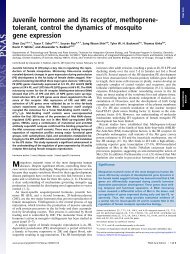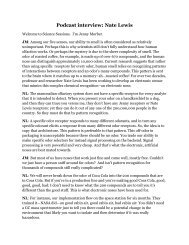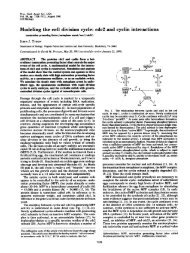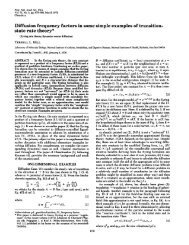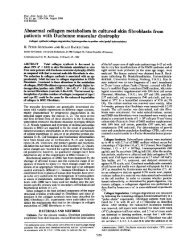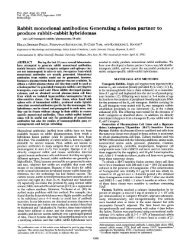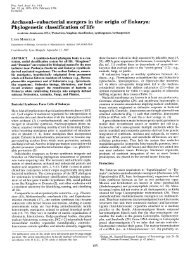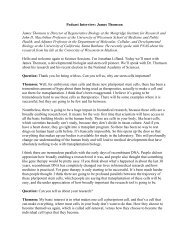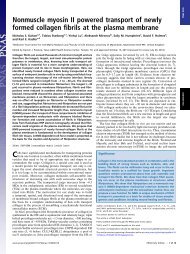Light-harvesting chlorophyll c-like pigment in Prochloron
Light-harvesting chlorophyll c-like pigment in Prochloron
Light-harvesting chlorophyll c-like pigment in Prochloron
You also want an ePaper? Increase the reach of your titles
YUMPU automatically turns print PDFs into web optimized ePapers that Google loves.
682 Microbiology: Larkum et al.<br />
U)<br />
0 657<br />
a:<br />
600 ~~720<br />
_<br />
636 628<br />
_ _ _ _ _ _ _ _ _ _ _ _ _ _ _<br />
A, nm<br />
FIG. 4. Low-temperature (77 K) fluorescence emission spectra of the LHC isolated from <strong>Prochloron</strong> sp. (from L. patella found at 10-m depth<br />
on One Tree Reef). (A) Isolated LHC excited by light at 440 nm. (B) LHC extract <strong>in</strong> 95% acetone/10% water excited at 440 nm. (C) LHC extract<br />
<strong>in</strong> 95% acetone/5% water excited at 470 nm. (D) LHC <strong>in</strong> 2% SDS and heated to 70°C for 5 m<strong>in</strong>, excited at 440 nm. (E) LHC <strong>in</strong> 2% SDS and<br />
heated to 70°C for 5 m<strong>in</strong>, excited at 470 nm.<br />
procedure (15) as the LHC had no detectable levels of the Chl<br />
c-<strong>like</strong> <strong>pigment</strong>, although Chl a and b were present, as shown<br />
previously (15). This evidence suggests that the Chl c-<strong>like</strong><br />
<strong>pigment</strong> is not <strong>in</strong>timately connected to photosystem I. The<br />
nature and function of the major LHC <strong>in</strong> <strong>Prochloron</strong> sp. and<br />
the presence of other LHCs have yet to be fully elucidated.<br />
It may be similar to LHC II of chlorophytes and higher plants<br />
and therefore associated with photosystem II (15), but neither<br />
its molecular location nor its primary structure has been<br />
reported.<br />
The occurrence of Chls a, b, and c <strong>in</strong> a light-<strong>harvest<strong>in</strong>g</strong> role<br />
<strong>in</strong> <strong>Prochloron</strong> raises many <strong>in</strong>trigu<strong>in</strong>g questions. The presence<br />
of an identical or similar Chl c-<strong>like</strong> <strong>pigment</strong> to that <strong>in</strong><br />
<strong>Prochloron</strong> seems <strong>like</strong>ly <strong>in</strong> Prochlorococcus mar<strong>in</strong>us, although<br />
it has yet to be shown <strong>in</strong> the latter organism whether<br />
the <strong>pigment</strong> acts <strong>in</strong> a light-<strong>harvest<strong>in</strong>g</strong> capacity and is found <strong>in</strong><br />
an LHC. Is Prochlorothrix hollandica, the other prochlorophyte,<br />
similar? Prelim<strong>in</strong>ary <strong>pigment</strong> analysis of that organism<br />
<strong>in</strong>dicates that MgDVP may be present <strong>in</strong> low concentrations<br />
(11). If this is substantiated, then all three prochlorophytes<br />
are <strong>like</strong>ly to conta<strong>in</strong> the Chl c-<strong>like</strong> <strong>pigment</strong>, although it would<br />
still be necessary to show that it acts <strong>in</strong> a light-<strong>harvest<strong>in</strong>g</strong><br />
capacity. At the moment it is possible to say that <strong>Prochloron</strong><br />
sp. and possibly each of the three prochlorophytes are more<br />
closely allied to the micromonadophyte chloroplast l<strong>in</strong>e (25,<br />
28) than to any other chloroplast l<strong>in</strong>e on the evidence that<br />
they all share a Chl c-<strong>like</strong> <strong>pigment</strong>. However, the dist<strong>in</strong>ct<br />
differences <strong>in</strong> the LHCs between <strong>Prochloron</strong> (15) and<br />
Prochlorothrix (29) on the one hand (the type of LHC <strong>in</strong><br />
Prochlorococcus is not known) and the micromonadophytes<br />
on the other hand (20, 30) (where the LHC is of the chromophytic<br />
type) stand aga<strong>in</strong>st a close aff<strong>in</strong>ity between these<br />
two groups. The recent f<strong>in</strong>d<strong>in</strong>g of div<strong>in</strong>yl Chl a and b <strong>in</strong><br />
Prochlorococcus (4, 11) and the evidence that both <strong>Prochloron</strong><br />
and Prochlorococcus share the presence of a Chl c-<strong>like</strong><br />
<strong>pigment</strong> raise the possibility that div<strong>in</strong>yl <strong>chlorophyll</strong>s a and b<br />
also exist <strong>in</strong> <strong>Prochloron</strong>.<br />
The occurrence of a Chl c-<strong>like</strong> <strong>pigment</strong> and Chl b [or<br />
div<strong>in</strong>yl-Chl b (11)] <strong>in</strong> all of the prochlorophytes would<br />
weaken the argument that these organisms are merely cyanobacteria,<br />
where Chl b orig<strong>in</strong>ated <strong>in</strong>dependently <strong>in</strong> each of<br />
the three groups (7-10). We believe that the phylogenetic tree<br />
analysis on which that argument was based is flawed (31-33).<br />
Another explanation is that the prochlorophytes are an<br />
anciently diverged group (34) widely separated from the<br />
Proc. Natl. Acad. Sci. USA 91 (1994)<br />
Cyanobacteria, as orig<strong>in</strong>ally suggested (2). Thus, all three<br />
known prochlorophytes may be only very distantly related to<br />
the green chloroplast and may have diverged considerably<br />
from each other. F<strong>in</strong>ally, the present evidence lends support<br />
to the recent suggestion that Chl c-<strong>like</strong> <strong>pigment</strong>s were present<br />
<strong>in</strong> the earliest photosynthetic prokaryotes (28).<br />
We are grateful to Dr. S. W. Jeffrey for the supply of M. pusilla.<br />
This work was supported by the Australian Research Council (Small<br />
Grants).<br />
1. Lew<strong>in</strong>, R. A. (1975) Phycologia 14, 153-160.<br />
2. Lew<strong>in</strong>, R. A. (1977) Phycologia 16, 217.<br />
3. Burger-Wiersma, T., Veenhuis, M., Korthals, H. J., Van de<br />
Wiel, C. C. M. & Mur, R. (1986) Nature (London) 320, 262-<br />
264.<br />
4. Chisholm, S. W., Olson, R. J., Zettler, E. R., Goericke, R.,<br />
Waterbury, J. B. & Welschmeyer, N. A. (1988) Nature (London)<br />
334, 340-343.<br />
5. Palmer, J. (1985) Annu. Rev. Genet. 19, 325-354.<br />
6. Meyer, T. E., Cusanovich, M. A. & Kamen, M. D. (1986)<br />
Proc. Natl. Acad. Sci. USA 83, 217-220.<br />
7. Turner, S., Burger-Wiersma, T., Giovannoni, J., Mur, L. R. &<br />
Pace, N. R. (1989) Nature (London) 337, 380-385.<br />
8. Morden, C. W. & Golden, S. S. (1991) J. Mol. Evol. 32,<br />
379-395.<br />
9. Palenik, B. & Haselkorn, R. (1992) Nature (London) 355,<br />
265-267.<br />
10. Urbach, E., Robertson, D. L. & Chisholm, S. (1992) Nature<br />
(London) 355, 267-270.<br />
11. Goericke, R. & Repeta, D. J. (1992) Limnol. Oceanogr. 37,<br />
425-433.<br />
12. Wright, S. W., Jeffrey, S. W., Mantoura, R. F. C., Llewellyn,<br />
C. A., Bjornland, T., Repeta, D. & Welschmeyer, N. (1991)<br />
Mar. Ecol. Prog. Ser. 77, 183-196.<br />
13. Jeffrey, S. W. & Humphrey, G. P. (1975) Biochem. Physiol.<br />
Pflanzen (BPP) 167, 191-194.<br />
14. Jeffrey, S. W. & Wright, S. W. (1987) Biochim. Biophys. Acta<br />
894, 180-188.<br />
15. Hiller, R. G. & Larkum, A. W. D. (1985) Biochim. Biophys.<br />
Acta 806, 107-115.<br />
16. Shioi, Y. & Beale, S. 1. (1987) Anal. Biochem. 162, 493-499.<br />
17. Loeblich, A. R. & Smith, V. E. (1968) Lipids 9, 5-13.<br />
18. Lew<strong>in</strong>, R. A. & Cheng, L. (1989) <strong>Prochloron</strong>: A Microbial<br />
Enigma (Chapman Hall, New York).<br />
19. Jeffrey, S. W. (1989) <strong>in</strong> The Chromophytic Algae: Problems<br />
and Perspectives, eds. Green, J. C., Leadbetter, B. S. C. &<br />
Diver, W. L. (Clarendon, Oxford, U.K.), pp. 13-36.<br />
20. Wilhelm, C. (1987) Biochim. Biophys. Acta 892, 23-29.



